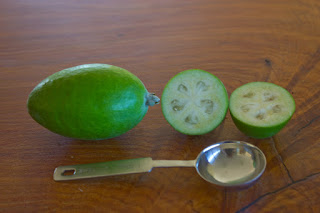We scooped our way through quite a number of feijoas trying to identify our varieties. We combined the images and tasting notes from the page above, with the excellent variety photographs at Waimea Nurseries,
This got me thinking, if feijoas have different levels of sugar affecting their sweetness, do they have different levels of pectin too? Pectin is the substance that in the right pH conditions (hence the lemon juice) forms the structure to make feijoa jelly set.
In previous year's my feijoa jelly has set as quite a stiff jelly but my last batch, while a different recipe, was not as well set. I began to wonder if the variety of feijoa had caused this difference in setting thickness. Perhaps one variety is particularly good for jelly.
Let the single variety feijoa jelly setting test begin!
I made the same basic feijoa jelly recipe for all five varieties.
1. Feijoas sliced and boiled in enough water to keep them covered until soft.
2. Fruit and liquid strained through muslin.
3. One cup of sugar, plus a teaspoon of lemon was added for every 500ml of fruit liquid.
4. The jelly was boiled until it reached 105C and poured into sterilised jars.
The feijoa jelly production line was set up with pots being cleaned between each variety to stop carryover.
One aspect that is hard to tell from the Country Trading images is size. I have added a tablespoon for size in my images below.
Feijoa variety one - believed to be Unique variety
Feijoa variety two - identified as Anatoki variety
Feijoa variety three believed to be Pounamu variety
Feijoa variety four identified as Apollo variety
Feijoa variety five believed to be Keiteri variety
Results
I waited until the following day and the best set jelly was variety one, believed to be unique variety. The second best was variety three believed to be pounamu variety, though anatoki (variety two) was also pretty good.
Conclusions
But like any decent experiment one needs to say; more needs to be done in this field of research. My varieties 4 and 5 have become dessert syrup. I wonder if this may be because I let the fruit boil for too long before straining it due to my production line of jelly making. I may have broken down the pectin. I really needed to boil them for a set length time each so this was controlled.
I also think ripeness was probably a factor. As fruit ripens, the pectin is broken down, so very ripe fruit has less pectin. Variety one and two had fruit that was less ripe than the other varieties and variety four, identified as apollo, were the most ripe to over ripe.
When making feijoa jelly in future, I think it is a good idea to think about the variety being used as its sweetness and pectin levels probably do mean differing amounts of sugar and lemon juice need to be added.
In other features, the nicest golden colour jelly was variety three, believed to be pounamu. The results on which one tasted the best? It is feijoa jelly - they are all delicious!
Note: Initially when identifying the feijoas we had thought it the number of seed pockets in the cut fruit were important. However for the jelly experiment, I collected the feijoas from the different bushes in different containers. We found the following in one container - five, three and four seed pockets. I believe these are all anatoki variety.
Note: Many feijoas were eaten during this experiment and the different varieties definitely do have their own individual flavour.
Happy to have the above feijoas better identified, if they are incorrectly labelled.










